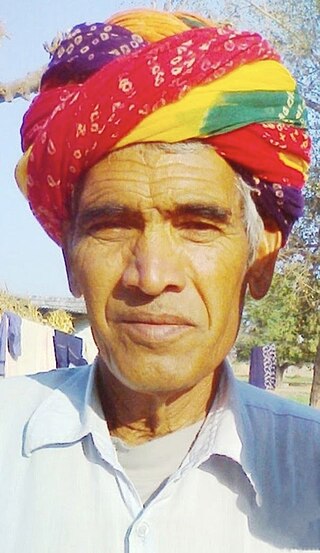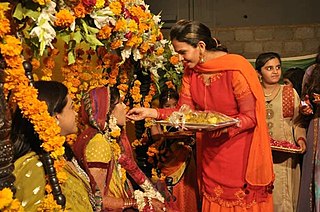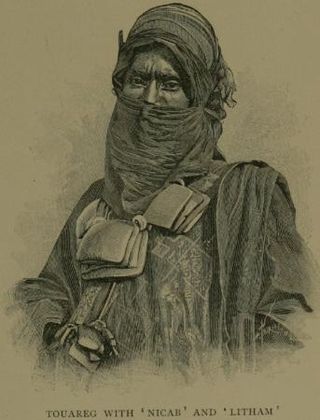
A turban is a type of headwear based on cloth winding. Featuring many variations, it is worn as customary headwear by people of various cultures. Communities with prominent turban-wearing traditions can be found in the Indian subcontinent, Southeast Asia, the Middle East, the Balkans, the Caucasus, Central Asia, North Africa, West Africa, East Africa, and amongst some Turkic peoples in Russia.

Giddha is a popular folk dance of women in the Punjab region. The dance is often considered derived from the ancient dance known as the ring dance and is just as energetic as bhangra; at the same time it manages to creatively display feminine grace, elegance and flexibility. It is a highly colourful dance form which has spread to all regions of India. Women perform this dance mainly at festive or social occasions. The dance is accompanied by rhythmic clapping, with a typical traditional folk song performed by elder women in the background.

The Juti or Jutti is a type of footwear common in North India, Pakistan, and neighboring regions. They are traditionally made up of leather and with extensive embroidery, in real gold and silver thread as inspired by royalty in the subcontinent over 400 years ago. Prior to that, Rajputs of the northwest used to wear leather juttis, also called ethnic shoes.

A dastār is an item of headwear associated with Sikhism and Sikh culture. The word is loaned from Persian through Punjabi. In Persian, the word dastār can refer to any kind of turban and replaced the original word for turban, dolband (دلبند), from which the English word is derived.

Punjabi culture grew out of the settlements along the five rivers which served as an important route to the Near East as early as the ancient Indus Valley civilization, dating back to 3000 BCE. Agriculture has been the major economic feature of the Punjab and has therefore formed the foundation of Punjabi culture, with one's social status being determined by landownership. The Punjab emerged as an important agricultural region, especially following the Green Revolution during the mid-1960's to the mid-1970's, has been described as the "breadbasket of both India and Pakistan". Besides being known for agriculture and trade, the Punjab is also a region that over the centuries has experienced many foreign invasions and consequently has a long-standing history of warfare, as the Punjab is situated on the principal route of invasions through the northwestern frontier of the Indian subcontinent, which promoted to adopt a lifestyle that entailed engaging in warfare to protect the land. Warrior culture typically elevates the value of the community's honour (izzat), which is highly esteemed by Punjabis.

Marriage in Pakistan pertains to wedding traditions established and adhered by Pakistani men and women. Despite their local and regional variations, marriages in Pakistan generally follow Islamic marital jurisprudence. Marriages are not only seen as a union between a husband and a wife, but also an alliance between their respective families. These traditions extend to other countries around in the world where Overseas Pakistani communities exist.
Religious clothing is clothing which is worn in accordance with religious practice, tradition or significance to a faith group. It includes clerical clothing such as cassocks, and religious habit, robes, and other vestments. Accessories include hats, wedding rings, crucifixes, etc.
Pakistani clothing refers to the ethnic clothing that is typically worn by people in the country of Pakistan and by Pakistanis. Pakistani clothes express the culture of Pakistan, the demographics of Pakistan, and cultures from Punjab, Sindh, Balochistan, Khyber Pakhtunkhwa, Gilgit-Baltistan, and Kashmir regions of the country. The clothing in each region and culture of Pakistan reflect weather conditions, way of living, the textiles and embroidery used and its distinctive style which gives it a unique identity among all cultures.
Pheta, also known as pataka, is a traditional turban worn in Maharashtra, India.
Pagri, sometimes also transliterated as pagari, is the term for turban used in the Indian subcontinent. It specifically refers to a headdress that is worn by men and women, which needs to be manually tied. Other names include sapho.

Shalwar kameez is a traditional combination dress worn by men and women in South Asia, and Central Asia.
Sikhism was founded in Punjab in 1469 by Guru Nanak on the foundations that everyone is equal, regardless of caste, age, or gender. Both men and women are supposed to follow the Five Ks: Kesh, Kangha (comb), Kara, Kachera and Kirpan, and there was never a distinction between what a woman should be allowed to do versus a man at theological level. Men and women are treated equally in the temple (gurdwara), and everyone eats and prays side-by-side. Both men and women are meant to carry the Kirpan with them as they are responsible for their own physical protection, and should not depend on others. Sikhs are strictly against the caste system and many chose to use Kaur or Singh as a last name to push against the problematic caste system in India. There is only one god (Waheguru) in Sikhism and they are without form or gender, and everyone is equal in the eyes of God. Many Sikh women believe that this absence of assignment of code of conduct for a woman versus a man proves that their religion is historically committed to gender equality. Presently, the culture does not always follow these traditions and equality is often more true in ideals rather than daily practice. According to Kiman Kaur: "It is essential to take into account the diverse Kaur narratives in order to critically understand the violence Sikh women experience due to religious, ethnic, and gender minoritization through enabling more intersectional conversations."
The Amils are a Sindhi sub-group of Bhaiband Lohana. The word "Amil" has its origin in the Persian word "amal". Amils used to work in Administration in Government services.
Turban training centre or turban tying centre or dastar academy are training institutes opened by professionals, who train Sikhs, in tying dastar on their heads. They also tie dastar for those people who do not know how to tie a turban, charging fees. Their regular clients include industrialists, businessmen, doctors, engineers, transporters and students.

Salwar or Shalwar is cloth worn from the waist to the ankles, covering both legs separately. It is the lower-garment of the Shalwar kameez suit which is widely-worn in South Asia. It is known for its lively hues, rich fabrics, and embroidery. It is also the national dress of Pakistan, and since the later 1960s with the salwar being used in government offices in Pakistan. The outfit has been a part of Punjabi tradition for centuries. Salwar can be distinguished from the Punjabi suthan which is shorter than the salwar.

In the Punjab region, people wore cotton clothing. Both men and women wore knee-length tops. A scarf was worn over the tops which would be draped over the left shoulder and under the right. A large sheet would be further draped over one shoulder which would hang loose towards the knees. Both male and female wore a dhoti around the waist. Modern Punjabi dress has retained the dhoti, but over its long history has added other forms of dress.

Sindhi clothing are a part of the Sindhi culture. Sindhi women and men wear the Shalwar Qameez or the Kurta with Pyjama. Women also wear Sari or ghagra. However, before the adoption of the Shalwar kameez, kurta, the Sari as well as other articles of clothing, Sindhis had their own traditional costumes.

Patiala Shahi is a style of turban (pagg) common among Sikh men, originating in Punjab, India.

Litham is a mouth-veil which the Tuareg and other North African nomads, particularly men, have traditionally used to cover the lower part of their face.

Folk dances of Sindh are the traditional dances of the Sindhi people, which are indigenous to Sindh region which is now in Pakistan. These dances are performed at various events including marriages, ceremonies, special occasions, on birth of a child and for cultural purposes.














